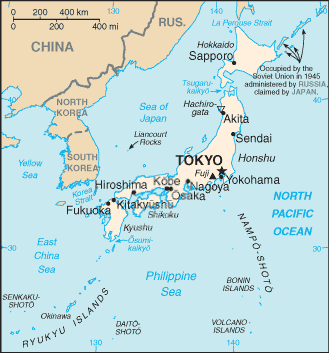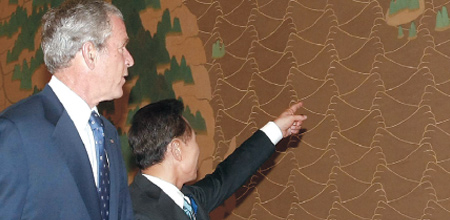Alexis Dudden
The United States government has landed itself in the middle of a major territorial dispute between Japan and Korea.
On July 25, with astonishing lack of knowledge, an obscure branch of the American government called the U.S. Board on Geographic Names (BGN) reversed fifty years of officially orchestrated avoidance concerning an ongoing battle between Japan and Korea. It decided that the United States would henceforth consider some tiny islands in the sea between them of “undesignated sovereignty.”
What’s the problem? Why would our government’s neutrality about some barely inhabited islands roughly the size of Central Park that have been under effective Korean control for six decades lead to emergency mid-flight phone calls to Secretary of State Condoleeza Rice as well as President George Bush’s subsequent personal reversal of the decision over specks of land most Americans have never heard of?
The answer is straightforward. Although the story does not begin with the Bush administration, this administration has consistently acted so haphazardly that its officials often openly have no idea what they are doing, let alone that their actions might have dangerous consequences. This instance fed into a more enduring issue involving Washington’s denial about the United States’ role in tensions between Japan and Korea leftover from the twentieth century. Although not immediately foreseeable, the results of this move hold the potential to make the Falklands War look like child’s play.
What makes the rocky outcrops that Koreans call “Dokdo”, the Japanese “Takeshima”, and the long known in the West as the Liancourt Rocks so treacherous?
Koreans claim they’ve been theirs for over a thousand years. The Japanese say they’re theirs, however, because their 1905 inclusion in Japan’s long-defunct empire makes them Japan’s now, never mind how the war ended in August, 1945.
Today, the island dispute is one of the signal flashpoints over who controls the history of the twentieth century. In its mix, the 1905 act came with American blessings and set the stage for Japan’s takeover of the Korean peninsula five years later.
Surprising to those unfamiliar with the hate that infuses the unresolved legacies of Japan’s colonization of Korea (1905-1945), even the hint of discussion over control of these islands can incense both Koreans and Japanese, but especially Koreans for whom these islands stand now as axiomatic of the nation’s pride, defined against Japan. Extravagant measures such as the Korean-sponsored full-page ad in a July New York Times proclaiming Dokdo as Korean are normal.
Until now, Washington has managed to keep the U.S out of the fray. Yet, last week brought us back to 1952, when America’s occupation of Japan ended, and the United States determined who owned what in East Asia and the Pacific.
In 1952, the United States commanded responsibility for designating sovereignty over the islands in question today. America sidestepped doing so at the time, making Washington’s feigned disinterest ever since the proverbial elephant in the room.
Immediately following World War II, the American government took control of Japanese and South Korean sovereignty. By occupying the region, then, the United States involved itself right away in the island controversy as well as in Japan and Korea’s problems, confronting the lived history of their recent era. In particular, the American drafters of the San Francisco Treaty—and especially John Foster Dulles—exercised enormous power when they geographically redefined what “Japan” meant, and the detritus of those decisions exists today in the form of the island disputes Japan has not only with Korea but also with China and Russia. The treaty effected Japan’s loss of the big obvious parts of the Asian mainland as well as the Kuriles, Taiwan, and Jeju, among other islands. At the same time, its authors granted America sole possession of the Bonin islands and Okinawa, which the United States has subsequently “given back,” although the sheer magnitude of U.S. military presence on Okinawa today continues to make many there wonder what sovereignty means.
During President Bush’s trip to Seoul last week en route to the Olympics, President Lee Myung-bak made a point of showing the world where the islands were and that they were Korean.
Washington must not overlook its place in the problem now. Despite great strides in the so-called soft power realm of cultural productivity and civic group activism, other political and social movements in Korea and Japan have a full head of steam and are headed on a collision course. The recent island flare-up, for example, involved the South Korean government canceling middle school exchange programs to Niigata and other regions. Bloggers in Japan of all political persuasions took Korea to task for dwelling in the past, which, noticeably, remains lacking in detail to many in Japan.
South Koreans have achieved a vibrant democracy and can hold their government accountable for its dealings with the United States. In Japan, the far right dominates the agenda of the center. Much of its strength derives from blaming the United States for stripping Japan of its historical prestige.
Washington’s blunder falls between these two forces, making any further attempt to sweep the mess under the rug impossible.
See Kimie Hara, Cold War Frontiers in the Asia Pacific. The Troubling Legacy of the San Francisco Treaty and Micronesia and the Postwar Remaking of the Asia Pacific: An American Lake.
Alexis Dudden is Associate Professor of History, University of Connecticut and a Japan Focus Associate. Her most recent book is Troubled Apologies Among Japan, Korea, and the United States.
She wrote this article for Japan Focus. Posted August 11, 2008.





